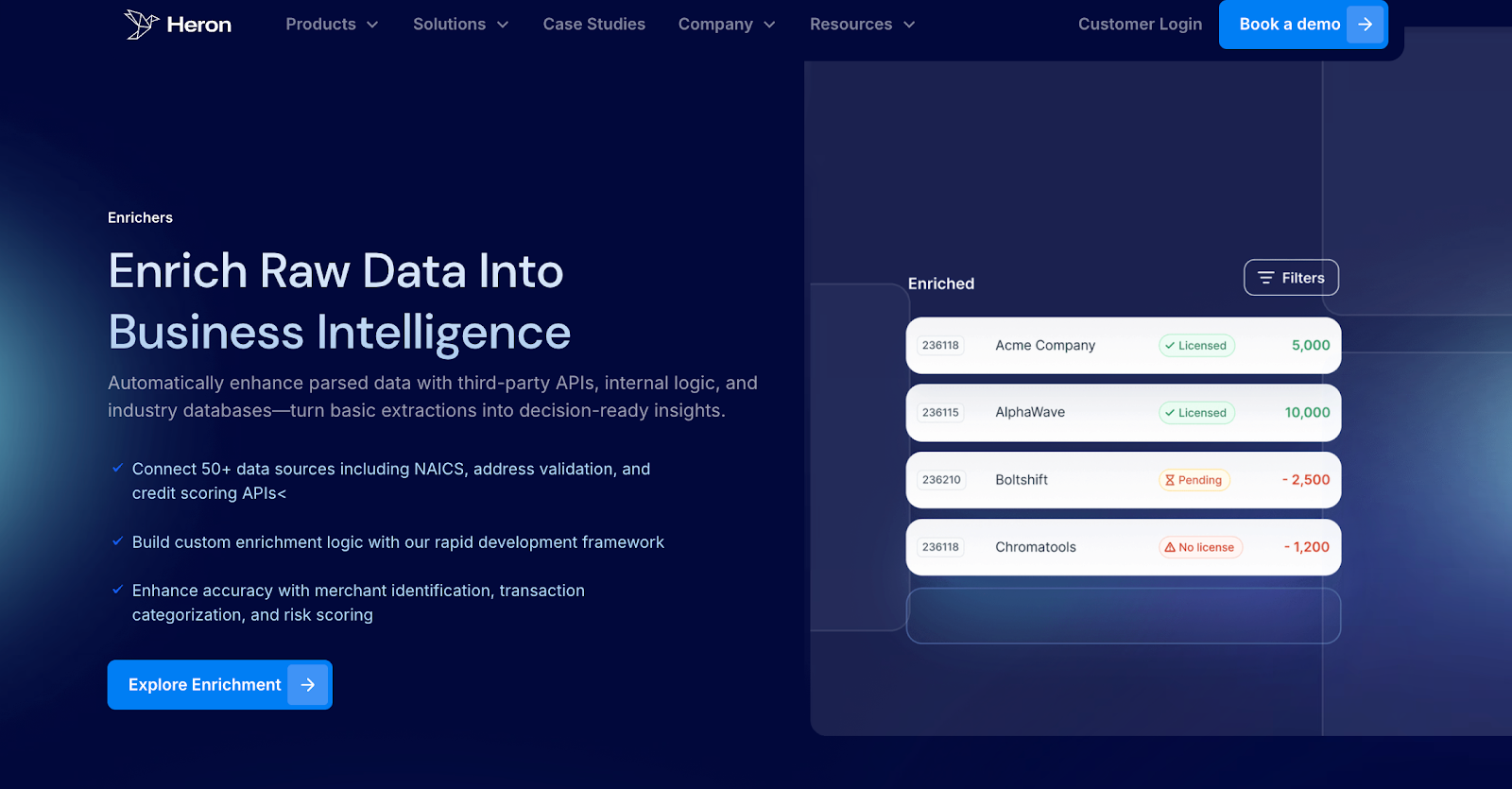Your underwriters are wasting 5 minutes per deal on SOS checks. We fixed that.
Today, Heron Data announces the launch of our SOS Checks product, a real-time verification solution that transforms one of lending's most tedious manual processes into instant, automated intelligence.
The Problem We're Solving
Ask any underwriter about their daily frustrations, and manual Secretary of State verification tops the list. Our research with 150+ funders revealed a startling reality:
- 5-10 minutes spent per application on manual SOS checks
- 250+ hours monthly for funders processing 5,000 applications
- 50+ different state websites to navigate, each with unique interfaces
- 2-3% miss rate due to naming variations and search quirks
- Week-old cached data from competitors is missing critical status changes
The math is simple but painful: at $25/hour, manual verification costs mid-sized funders over $10,000 monthly in labor alone. That's before accounting for deals lost to faster competitors or fraud that slips through stale data.
How Heron's SOS Checks Changes the Game
Real-Time Data, Not Cached Databases
Unlike providers relying on weekly database updates, Heron pulls directly from Secretary of State systems in real time. When a business was dissolved yesterday, we catch it today, not next week, after you've already funded them.
Intelligent Query Processing
Our system automatically handles the variations that trip up manual searches. "ABC, Inc." vs "ABC Inc" vs "ABC Incorporated". We match them all with 98% accuracy, catching the discrepancies and other additional information that human searches might miss.
Complete Coverage, Instant Response
- All 50 states + D.C. in a single API call
- Sub-second response times, even during peak periods
- Full audit trails with timestamped screenshots for compliance
What Is SOS Verification?
Now that we've introduced our solution, let’s go one step back and explain what Secretary of State verification is. It is the process of confirming a business entity's legal status by checking official state records.
Every business registered in the United States must file with its state's Secretary of State office (or equivalent agency), creating a public record of its:
- Legal business name and any DBAs (Doing Business As)
- Entity type (LLC, Corporation, Partnership, etc.)
- Registration status (Active, Dissolved, Suspended)
- Formation or registration date
- Registered agent information
- Principal place or office address
- Officer and director information (in states where public)
- Tax status and compliance standing with the Internal Revenue Code (IRC)
Why Is SOS Verification Critical for Funders?
Secretary of State verification remains one of the most important, yet overlooked, components of lending due diligence.
When evaluating business loan applications, verifying a company’s legal standing is fundamental to risk assessment and regulatory disclosure requirements.
Secretary of State verification confirms whether a business is legally conducting business in its registered state and that its filings are current. This step helps funders avoid deals with inactive or non-compliant entities.
By respecting proper verification procedures, funders gain confidence in the accuracy of each step in the course of their due diligence.
Traditionally, this has been one of the most time-consuming manual tasks in modern underwriting workflows. While many states now offer online databases, funders still face challenges with inconsistent formats and outdated information.
What Is a SOS Verification API?
A SOS Verification API is a digital tool that helps you instantly access official business data from any U.S. Secretary of State office.
Instead of spending time searching multiple state websites or sending mail requests, you can quickly gather verified details about a company’s registration, compliance, and active status.
As a funder, this financial automation tool helps you determine if a business is properly registered before approving loans or entering into any financial agreement.
You can also use it to review information relating to a company’s formation documents, registered agent, and filing history.
The SOS Verification API automates what used to be a slow manual process, giving you reliable data about your clients in seconds.
Whether you’re reviewing one person’s business or hundreds, automation helps you refer to accurate state records without exception.
Why SOS Verification Matters in Lending
Confirming Business Existence
The most basic yet critical check: does this business legally exist? Fraudsters often submit applications for non-existent or dissolved entities. Without verification, funders risk funding phantom companies.
Assessing Operational Risk
A business listed as "suspended" or "not in good standing" signals potential issues:
- Unpaid state fees or taxes
- Failure to file required reports
- Legal compliance problems
- Potential inability to legally operate
These red flags often correlate with higher default rates.
Validating Business Information
SOS records help verify:
- The applicant's claimed business formation date (newer businesses carry a higher risk)
- Whether the person applying has the authority to act on behalf of the business
- If the business name and structure match the application
Meeting Compliance Requirements
Many lending regulations and investor agreements require documented verification of borrower legitimacy. SOS checks provide auditable proof of due diligence.
The Current State of Manual SOS Verification
Most funders still perform SOS checks manually, following this typical workflow:
- Navigate to the appropriate state website - Each state maintains its own database with unique interfaces
- Search for the business - Deal with variations in search functionality and naming conventions
- Review the results - Interpret different data formats and terminology across states
- Document findings - Screenshot or copy information into internal systems
- Repeat for businesses registered in multiple states – Perform the same process across each applicable state database.
The Hidden Costs
Our analysis of 150+ funders reveals the true impact:
- Time investment - 5-10 minutes per application
- Volume impact - For a lender processing 5,000 applications monthly, that's 250-400+ hours
- Error rate - Manual searches miss approximately 2-3% of matches due to naming variations
- Data staleness - Some third-party databases use cached data that's days or weeks old
Common Challenges in SOS Verification
Naming Variations
Businesses may be registered as "ABC, Inc." but apply as "ABC Inc" or "ABC Incorporated." Manual searches often miss these matches.
Multi-State Complexities
Businesses operating across state lines may be registered in multiple jurisdictions, each with different statuses.
Website Inconsistencies
State websites vary dramatically in:
- Search capabilities
- Data availability
- Response times
- Maintenance schedules
Data Interpretation
Terms like "Active," "Good Standing," "Current," and "Compliant" mean different things in different states, requiring expertise to interpret correctly.
Human Error
Even a simple typo during SOS checks can make you pay later. These small errors slow your services and create more work for your team.
The Evolution: Automated SOS Verification
Modern API-based solutions are transforming SOS verification from a manual bottleneck into an automated workflow. Here's how automation addresses traditional challenges:
Unified Access
Instead of navigating 50+ different websites, automated systems provide single-point access to all state databases.
Intelligent Matching
Advanced algorithms handle naming variations, automatically matching "ABC Inc." with "ABC, Inc." and other permutations.
Real-Time Data
Direct API connections to state databases ensure current information, not cached data from days or weeks ago.
Standardized Output
Automated systems translate varying state terminologies into consistent, actionable business intelligence.
Audit Trails
Every verification generates timestamped documentation, creating compliant audit trails without manual screenshots.
Easier Compliance with Internal Revenue Code
Automated SOS verification supports accurate tax reporting, validates entity status, and keeps your funding process consistent with federal and state law.
Best Practices for SOS Verification
Whether manual or automated, effective SOS verification should:
- Check primary registration state - Always verify the state of incorporation/formation first
- Verify foreign registrations - Check states where the business operates but isn't domiciled
- Look beyond status - Review filing history for patterns of non-compliance
- Cross-reference information - Validate SOS data against application details
- Document everything - Maintain clear records for compliance and audit purposes
- Update regularly - For existing borrowers, periodic re-verification catches status changes
Key Metrics to Track
Organizations should monitor their SOS verification process through:
- Time per verification - Baseline and track improvements
- Error/miss rate - How often manual searches miss valid matches
- Status change detection - How quickly you identify when existing borrowers' status changes
- Coverage completeness - Percentage of applications with completed SOS checks
The Future of SOS Verification in Lending
As lending continues to digitize, manual SOS verification increasingly becomes an operational bottleneck. Organizations that haven't yet automated this process face several decisions:
- Build vs. buy - Developing in-house automation versus implementing existing solutions
- Integration planning - How SOS verification fits into broader workflow automation
- Data strategy - Using SOS data beyond simple yes/no decisions
The trajectory is clear: automated SOS verification is becoming table stakes for competitive lending operations. The question isn't whether to automate, but how quickly organizations can adapt.
Automatically Verify Business Legitimacy with Heron

SOS verification remains a cornerstone of lending due diligence. While the fundamental importance hasn't changed, the methods available have evolved dramatically.
Understanding both the critical nature of this verification and the operational impact of different approaches helps organizations make informed decisions about their underwriting processes.
For funders still relying on manual processes, the opportunity cost continues to grow, not just in hours spent, but in the competitive advantage gained by faster, more accurate verification.
As the lending landscape becomes increasingly competitive, the efficiency of foundational processes like SOS verification can make the difference between winning and losing deals.
That's where advanced tools like Heron come in. Heron’s Secretary of State verification tool confirms business registration, corporate filings, and entity details from official databases.
It also connects to 50+ trusted data sources, including credit bureaus, NAICS databases, and address validation tools.
This confirms each merchant is legally registered, active, and compliant before funding. Heron delivers speed, accuracy, and compliance while keeping your team efficient.
For more information about modernizing your verification processes, explore our resources on underwriting automation and API integration.
FAQs About Secretary of State Verification Lending
What is CIP verification, and how does it differ from business verification?
CIP verification checks a consumer’s identity using details like their social security numbers, address, and ID to meet banking rules.
Business verification, on the other hand, confirms the legal status of a company and its owner through official records or a certificate from state databases.
What is a Secretary of State API?
A Secretary of State API lets businesses verify company details directly from official state records. It helps confirm the certificate of formation, business status, and registered agent info, keeping data accurate when dealing with other businesses or partners.
What is the loan verification process?
The loan verification process confirms a borrower’s information before approving a mortgage or personal loan.
It checks income, savings, employment, and identification to protect both funders and customers. Funders may notify or contact the subject to be present or provide documents if more proof is needed.
How do you check a business's credit history?
To check a business’s credit history, request a report from a credit bureau or financial platform that tracks company credit. You can call by phone or access it online, often for a free copy.
The report shows how a business handles its money, whether it's with payments, transactions with merchants and other marketplaces, etc, which helps others note its reliability before forming partnerships or extending credit.

.jpg)
